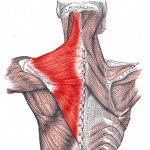Written by Ethan Baxter
The trapezius other known as the traps consist of three parts:
- The superior region which is the descending part or Upper fibers which function is to support the weight of the arm.
- The intermediate region which is the transverse part or middle fibers, which functions are to draw or pull the scapula inwards or closer to the spine.
- The inferior region which is the ascending part or Lower Fibers, which functions are to rotate and or lower the scapula.
The trapezius has a few functions such as:
- Movement of the scapula in toward the spine
- Movement of the rotation of the scapula to support the topmost part of the upper arm.
- Movement of the Scapula in an up or down direction.
- Movement of the head and neck in a backwards direction
- Movement to the side of the head and neck
- Assisting in breathing- The Trapezius muscle is also considered an accessory breathing muscle meaning it assists the breathing function by slightly enlarging the upper chest region to increase the breathing capacity of the lungs.
In the three sections of the trapezius there are 6 trigger points which can cause distinctive pain in your body.
In the upper trapezius the referred pain from this trigger point can be a cause of pain in the back of your neck and also down your back it could also be a cause of some of your headaches.
In the middle trapezius the referred pain from this trigger point doesn’t travel far and the pain would stay in the local region.
In the lower trapezius the referred pain from this trigger point would be felt on the tip of your shoulder joint. This trigger point is extremely common and is responsible for the feeling of the “weight of the world on my shoulders” that we are all very familiar too.
There are many ways to help alleviate the pain from the trapezius and if it is to do with trigger points there Is no better way than dry needling as it targets the trigger points and relieves the pain.



